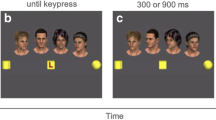Abstract
In a novel implicit learning task, participants responded to a target stimulus that could appear in one of three locations. Unknown to participants, the location in which the target appeared was probabilistically determined on the basis of the location of eye-gaze immediately prior to the appearance of the target. Participants’ response times to the appearance of the target in a high-probability location were faster than when it appeared in a low-probability location, revealing that participants were able to learn these gaze-contingent events. Furthermore, there was no difference in the cuing score between those participants classified as aware or unaware of the contingencies on a subsequent forced-choice recognition task. These data suggest the task involves implicit learning of instrumental (action-outcome) contingencies, which has potential implications for our understanding of gaze-contingent processes in social interaction.


Similar content being viewed by others
Notes
See supplemental material for detailed analysis of the stimulus-gaze events.
The threshold for stimulus-gaze event lags of 500 ms ensures that our analysis examines only those trials in which there was reasonable contiguity between the stimulus-gaze event and the target presentation. The duration of 500 ms also ensures that the analysis retains a large proportion of the trials. However, it should be noted that the critical effect of faster responding on frequent- over infrequent-mismatch trials is observed across a range of lags, including when the analysis is restricted to trials in which there was no lag (0 ms), t(39) = 4.58, d = .84, p < .001.
We thank Ian McLaren for suggesting this alternative account.
References
Cleeremans, A., & Jiménez, L. (2002). Implicit learning and consciousness: A graded, dynamic perspective. In R. M. French & A. Cleeremans (Eds.), Implicit Learning and Consciousness (pp. 1–40). Hove, UK: Psychology Press.
Cleeremans, A., & McClelland, J. L. (1991). Learning the structure of event sequences. Journal of Experimental Psychology: General, 120, 235–253.
Destrebecqz, A., & Cleeremans, A. (2001). Can sequence learning be implicit? New evidence with the process dissociation procedure. Psychonomic Bulletin & Review, 8, 343–350.
Deubel, H., & Schneider, W. X. (1996). Saccade target selection and object recognition: Evidence for a common attentional mechanism. Vision Research, 36, 1827–1837.
Frensch, P. A., Lin, J., & Buchner, A. (1998). Learning versus behavioral expression of the learned: The effects of a secondary tone-counting task on implicit learning in the serial reaction task. Psychological Research, 61, 83–98.
Jiménez, L., Méndez, C., & Cleeremans, A. (1996). Comparing direct and indirect measures of sequence learning. Journal of Experimental Psychology: Learning, Memory, and Cognition, 22, 948–969.
Kunar, M. A., Flusberg, S. J., Horowitz, T. S., & Wolfe, J. M. (2007). Does contextual cuing guide the deployment of attention? Journal of Experimental Psychology: Human Perception and Performance, 33, 816–828.
Le Pelley, M. E., Mitchell, C. J., & Johnson, A. M. (2013). Outcome value influences attentional biases in human associative learning: Dissociable effects of training and of instruction. Journal of Experimental Psychology: Animal Behavior Processes, 39, 39–55.
Mason, M. F., Tatkow, E. P., & Macrae, C. N. (2005). The look of love: Gaze shifts and person perception. Psychological Science, 16, 236–239.
Shanks, D. R. (2005). Implicit learning. In K. Lamberts & R. L. Goldstone (Eds.), Handbook of Cognition (pp. 202–220). London: Sage.
Shanks, D. R. (2010). Learning: from association to cognition. Annual Review of Psychology, 61, 273–301.
Shanks, D. R., & Johnstone, T. (1999). Evaluating the relationship between explicit and implicit knowledge in a sequential reaction time task. Journal of Experimental Psychology: Learning, Memory, and Cognition, 25, 1435.
Shanks, D. R., & Perruchet, P. (2002). Dissociation between priming and recognition in the expression of sequential knowledge. Psychonomic Bulletin & Review, 9, 362–367.
Shanks, D. R., Rowland, L. A., & Ranger, M. S. (2005). Attentional load and implicit sequence learning. Psychological Research, 69, 369–382.
Shanks, D. R., & St. John, M. F. (1994). Characteristics of dissociable human learning systems. Behavioral and Brain Sciences, 17, 367–395.
Symons, L. A., Hains, S. M. J., & Muir, D. W. (1998). Look at me: Five-month-old infants’ sensitivity to very small deviations in eye-gaze during social interactions. Infant Behavior and Development, 21, 531–536.
Author information
Authors and Affiliations
Corresponding author
Electronic supplementary material
Below is the link to the electronic supplementary material.
ESM 1
(PDF 53 kb)
Appendix
Appendix
Forced-choice recognition test for awareness of task contingencies

Rights and permissions
About this article
Cite this article
Beesley, T., Pearson, D. & Le Pelley, M. Implicit learning of gaze-contingent events. Psychon Bull Rev 22, 800–807 (2015). https://doi.org/10.3758/s13423-014-0720-4
Published:
Issue Date:
DOI: https://doi.org/10.3758/s13423-014-0720-4




